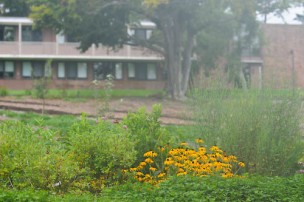On Tuesday, April 22, community members gathered in Zilkha Gallery to learn about the work of ENVS 420: Building Resilient Landscape Systems: The Intersection of Deep Ecology and Sustainable Landscape Design. Led by Manon Lefevre ’14 and William Wiebe ’14, the student forum has partnered with the group Working for Intelligent Landscape Design at Wesleyan (WILD Wes) to produce plans for planting the West College (WestCo) Courtyard.
Lefevre, a WILD Wes member since the group’s founding, has been involved in the project for four years.
“This is our fifth student forum,” Lefevre said. “We try to do one every semester. It’s the best platform to work on design and research, because you have a committed group of students. It legitimizes the project when it’s made more academic.”
On the walls of the gallery hung three enormous maps, each with a different section of the WestCo Courtyard colored in to demonstrate the group’s plan for that specific section: the forest garden, the forest mimic, or the meadow. Near the entrance of the gallery read the group’s mission statement: “Pressing environmental problems compel us to question intensive lawn care, inspiring us to instead imagine innovative landscape designs that use wildflowers, native plants, and edible fruit trees to knit our community together around a practical expression of our commitment to sustainability while simultaneously beautifying our campus.”
The group also displayed a timeline of WILD Wes’ progress, beginning in spring 2011 with its first forum, in which students created a design and implementation plan, and leading up to summer 2013, during which four WILD Wes interns worked on planting the space near WestCo. The work of planting is ongoing and runs concurrently with planning; the forum’s members will finish the year by continuing that hands-on work.
Sara Feldman ’17 is a member of the forest garden team, which created a plan for a self-sustainable, largely edible, and generally healthy space.
“My favorite part was getting to choose plants I know will produce food,” she said. “It’s great to make it into an interactive space. I love plants. I really like the idea of using our space to be productive as well as beautiful. Anyone on campus can take food from it, so it brings people together.”
Although the forest garden team has designed a place for the community to harvest crops such as blueberries, peaches, and herbs, the forest mimic group was faced with combating invasive species, erosion, and salt runoff that have all plagued the area.
“We’re trying to re-create a natural habitat in the forest of Connecticut,” said Carlos Sanchez ’14, a member of the forest mimic group, when he and his teammates presented their work in front of the small crowd. “We’re using native plants.”
The final group, devoted to the meadow, was focused on developing a social space; the members of this group chose plants that vary in color, size, and blooming season to create, in the words of the stated goals hanging on the wall, “a beautiful, aesthetically pleasing area.”
The forum has been especially useful to member Laura Cohen ’14, who works at Long Lane Farm as well as on the WestCo space; she explained that the two projects complemented each other nicely.
“I’ve loved learning how to create polycultures and how to plant designs, because we’re working on a similar project at Long Lane,” Cohen said. “[At Long Lane] we’ve been planting an experimental permaculture forest garden, with just a few trees and hoping for more. It’s a really hands-off, food-producing space.”
Although she had taken a course in permaculture design before enrolling in the forum, Cohen has enjoyed the increased exposure to the principles of sustainability and intelligent planting.
“Every time [you work on a project] you learn more here and there,” she said. “It just reinforces it. I’m excited to plant all of it. There’s a lot of different kinds of ground cover—wild ginger, yarrow. I’m really excited to work on the [WestCo] Courtyard site, because I’ve never worked on a WILD Wes site before—just the farm. It’s good to be involved in both projects.”
Angela Goldberg ’15 has also enjoyed working with the logistics of planting.
“My favorite part has been coming up with the actual design, figuring out what should go where,” she said.
Lefevre expressed her gratitude to the Green Fund, as well as to the College of the Environment, both of which sponsor the course each time it is taught. She did, though, emphasize the need for the University to take more seriously its commitment to intelligent landscape design.
“I hope [these sustainable practices] will be institutionalized,” Lefevre said. “The University doesn’t recognize landscape design as a serious project.”
In five to ten years, Lefevre is hopeful that the physical space will continue to grow and develop, and along with sustainable practices that will extend to the rest of campus.
“I’m excited to see how the physical space keeps on changing,” Lefevre said. “It’s hard for most students to gauge what it used to look like. There were no events; it was not an exciting space. I hope the group continues to work with Physical Plant. I hope it becomes something that the University cares about on an institutional level. It’s one small project on a big campus where there are unsustainable practices in general. I hope there’s a real shift.”

Comments are closed